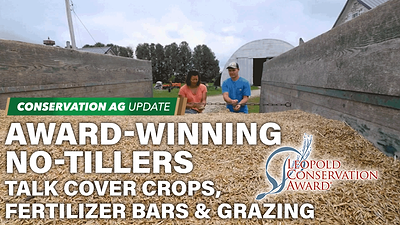More and more African farmers have turned to conservation tillage to maintain the health of the soil in their fields.
According to the University of Minnesota, which cooperates on agricultural research with the U.S. Department of Agriculture, conservation tillage is any method of soil cultivation that leaves residue from the previous season’s crop — for instance, maize stalks or wheat stubble — on a field before and after planting the next season’s crop. Traditionally, farmers ploughed residue back into the soil before planting a new crop.
Maize grows in rows surrounded by residue from last season’s crop.
Conservation tillage, which has gained in popularity worldwide in recent decades, improves on the traditional method because it enables roots to better capture plant nutrients and water, enhancing crop growth in dry periods or in dry soil. In the long term, it helps communities develop resilience to weather extremes that cause fluctuating growing conditions, according to the U.S. Agency for International Development (USAID).
The Food and Agriculture Organization of the United Nations (FAO) promotes conservation tillage as a way to protect soils from erosion leading to desertification. “The current rate of soil degradation threatens the capacity of future generations to meet their needs,” states the agency, which adopted 2015 as the International Year of Soils.
Conservation tillage methods include no-till, strip-till, ridge-till and mulch-till:
- No-till and strip-till involve planting crops directly into residue from the previous season’s crop that hasn’t been tilled (no-till) or has been tilled only in narrow strips with the rest of the field left untilled (strip-till).
- Ridge-till involves planting row crops on permanent ridges about 12 centimeters high. The previous crop’s residue is cleared off ridges into adjacent furrows. Maintaining the ridges is essential.
- Mulch-till is a method that leaves at least 30 percent of the soil surface covered with crop residue.
Research shows that conservation tillage also benefits the environment by:
- Reducing soil erosion by as much as 60 percent, depending on the tillage method and amount of residue left to shield soil from rain and wind.
- Adding organic matter to soil.
- Decreasing farmers’ expenditures on fuel and planting because fewer tractor trips across the field are needed.
- Reducing potential air pollution from dust and diesel emissions.
- Reducing soil compaction that can interfere with plant growth.
As an added benefit, crop residue provides food and cover for wildlife, while buffers like grass strips and forests adjacent to waterways defend against water pollution by trapping and filtering any sediment that does leave the field.





